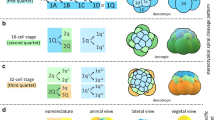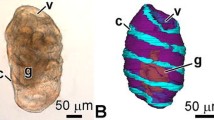Abstract
The embryonic development of the flatworm Mesostoma lingua was studied using a combination of life observation and histological analysis of wholemount preparations and sections (viewed by both light and electron microscopy.) We introduce a series of stages defined by easily recognizable morphological criteria. These stages are also applicable to other platyhelminth taxa that are currently under investigation in our laboratory. During cleavage (stages 1 and 2), the embryo is located in the center of the egg, surrounded by a layer of yolk cells. After cleavage, the embryo forms a solid, disc-shaped cell cluster. During stage 3, the embryo migrates to the periphery of the egg and acquires bilateral symmetry. The side where it contacts the egg surface corresponds to the future ventral surface of the embryo. Stage 4 is the emergence of the first organ primordia, the brain and pharynx. Gastrulation, as usually defined by the appearance of germ layers, does not exist in Mesos-toma; instead, organ primordia emerge ”in situ” from a mesenchymal mass of cells. Organogenesis takes place during stages 5 and 6. Cells at the ventral surface form the epidermal epithelium; inner cells differentiate into neurons, somatic and pharyngeal muscle cells, as well as the pharyngeal and protonephridial (excretory) epithelium. A junctional complex, consisting initially of small septate junctions, followed later by a more apically located zonula adherens, is formed in all epithelial tissues at stage 6. Beginning towards the end of stage 6 and continuing throughout stages 7 and 8, cytodifferentiation of the different organ systems takes place. Stage 7 is characterized by the appearance of eye pigmentation, brain condensation and spindle-shaped myocytes. Stage 8 describes the fully dorsally closed and differentiated embryo. Muscular contraction moves the body in the egg shell. We discuss Mesostoma embryogenesis in comparison to other animal phyla. Particular attention is given to the apparent absence of gastrulation and the formation of the epithelial junctional complex.
Similar content being viewed by others
Author information
Authors and Affiliations
Additional information
Received: 10 February 2000 / Accepted: 10 April 2000
Rights and permissions
About this article
Cite this article
Hartenstein, V., Ehlers, U. The embryonic development of the rhabdocoel flatworm Mesostoma lingua (Abildgaard, 1789). Dev Gene Evol 210, 399–415 (2000). https://doi.org/10.1007/s004270000085
Issue Date:
DOI: https://doi.org/10.1007/s004270000085




